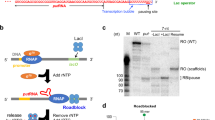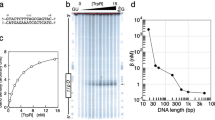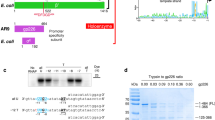Abstract
The sequence of 33 nucleotides immediately preceding the start point of transcription of an operon in bacteriophage lambda has been determined. This region includes recognition sites for lambda repressor and, probably, for other proteins. The sequence contains interdigitating symmetries.
This is a preview of subscription content, access via your institution
Access options
Subscribe to this journal
Receive 51 print issues and online access
$199.00 per year
only $3.90 per issue
Buy this article
- Purchase on Springer Link
- Instant access to full article PDF
Prices may be subject to local taxes which are calculated during checkout
Similar content being viewed by others
References
Maniatis, T., and Ptashne, M., Proc. natn. Acad. Sci. U.S.A., 70, 1531 (1973).
Maniatis, T., and Ptashne, M., Nature, 246, 133 (1973).
Maniatis, T., Ptashne, M., and Maurer, R., Cold Spring Harbor Symp. quant. Biol., 38, 857 (1973).
Maurer, R., Maniatis, T., and Ptashne, M., Nature, 249, 221 (1974).
Allet, R., and Solem, R., J. molec. Biol., 85, 475 (1974).
Chadwick, P., Pirrotta, V., Steinberg, R., Hopkins, N., and Ptashne, M., Cold Spring Harbor Symp. quant. Biol., 35, 283 (1970).
Blattner, F. R., and Dahlberg, J. E., Nature new Biol., 237, 227 (1972).
Sanger, F., Donelson, J. E., Coulson, A. R., Kossel, H., and Fischer, D., Proc. natn. Acad. Sci. U.S.A., 70, 1209 (1973).
Kelly, T. J., and Smith, H. O., J. molec. Biol., 51, 393 (1970).
Blattner, F. R., Dahlberg, J. E., Boettiger, J. K., Fiandt, M., and Szybalski, W., Nature new Biol., 237, 232 (1972).
Heyden, B., Nusslein, C., and Schaller, H., Nature new Biol., 240, 9 (1972).
Gilbert, W., and Maxam, A., Proc. natn. Acad. Sci. U.S.A., 70, 3581 (1973).
Maizels, N. M., Proc. natn. Acad. Sci. U.S.A., 70, 3585 (1973).
Gilbert, W., Maizels, N. M., and Maxam, A., Cold Spring Harbor Symp. quant. Biol., 38, 845 (1973).
Sly, W. S., Rabideau, K., and Kolber, A., in The bacteriophage lambda (edit. by Hershey, A.), 221–231 (Cold Spring Harbor Laboratory, New York, 1971).
Franklin, N., J. molec. Biol. (in the press).
Adhya, S., Gottesman, M., de Crombrugghe, B., Proc. natn. Acad. Sci. U.S.A. (in the press).
Szybalski, W., Kubinski, H., Hradecna, Z., and Summers, W. C., in Methods in enzymology, 21, Part D (edit. by Grossman, L., and Moldave, K.), 383 (Academic Press, New York, 1971).
Author information
Authors and Affiliations
Rights and permissions
About this article
Cite this article
Maniatis, T., Ptashne, M., Barrell, B. et al. Sequence of a represser-binding site in the DNA of bacteriophage λ. Nature 250, 394–397 (1974). https://doi.org/10.1038/250394a0
Received:
Revised:
Issue Date:
DOI: https://doi.org/10.1038/250394a0
This article is cited by
-
Repair-modification and evolution of the eukaryotic genome organization
Cell Biophysics (1989)
-
The use of the plasmid pHA10 in the isolation of λP L promoter mutations
Molecular and General Genetics MGG (1982)
-
Structure and distribution of inverted repeats (palindromes)
Chromosoma (1981)
-
DNA sequence of a plasmid-encoded dihydrofolate reductase
Molecular and General Genetics MGG (1981)
-
Organization, replication and modification of the human genome: Synthesis and methylation of palindromic, repeated and unique hela nDNA sequences during the S-phase
Molecular Biology Reports (1980)
Comments
By submitting a comment you agree to abide by our Terms and Community Guidelines. If you find something abusive or that does not comply with our terms or guidelines please flag it as inappropriate.



